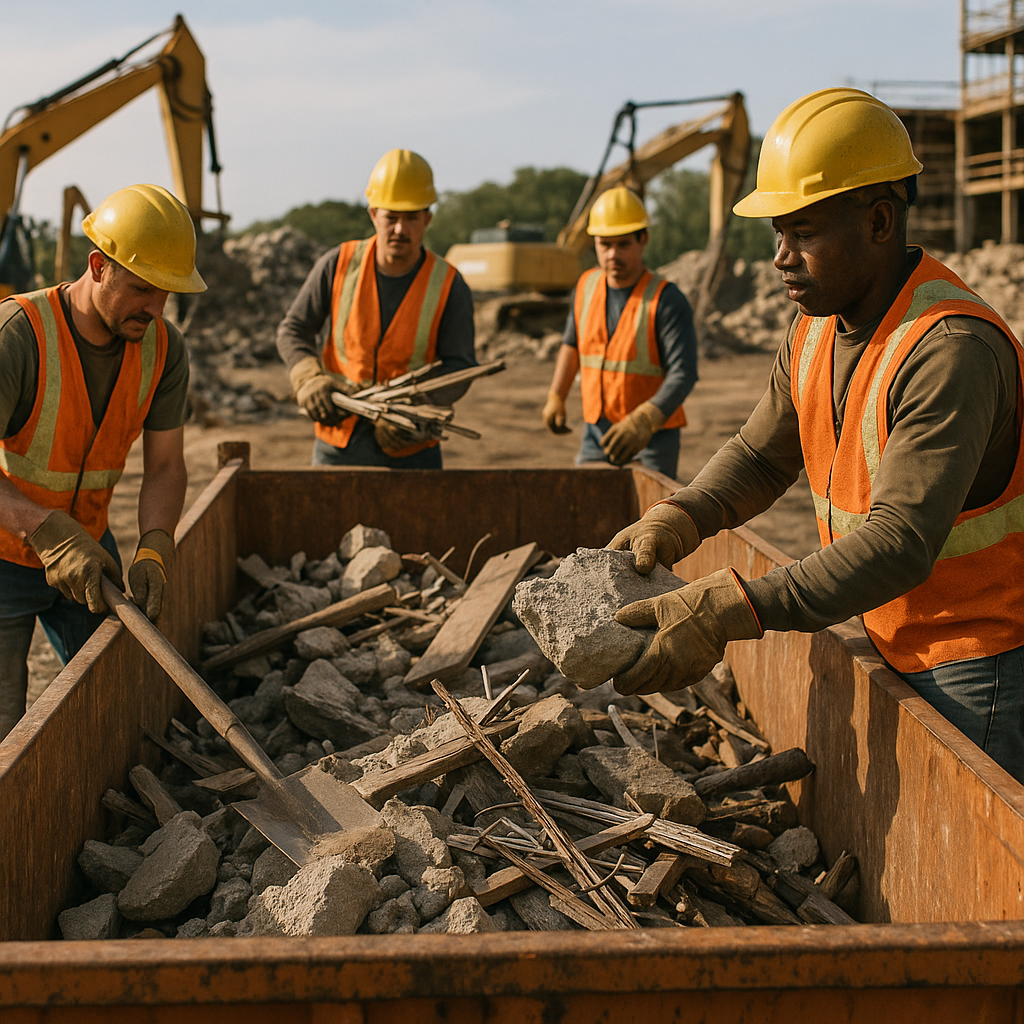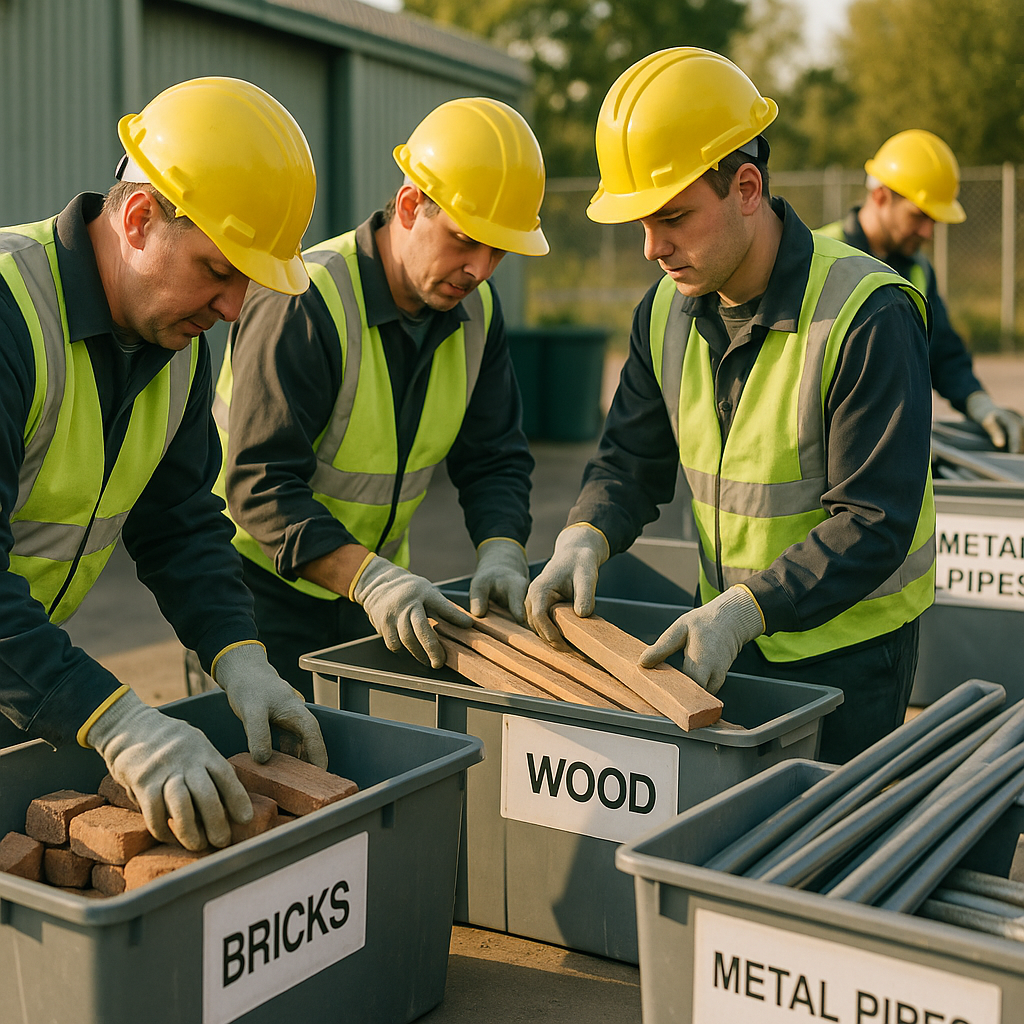5901 Botham Jean Blvd, Dallas, TX 75215
How to Dispose Construction Debris Properly
July 20, 2025Did you know that construction and demolition waste increased by 342% between 1990 and 2018? According to the EPA, this waste now represents nearly one-third of all materials in landfills across the country. Construction debris encompasses a wide range of materials generated during building, renovation, and demolition projects, including concrete, wood, metal, drywall, asphalt, plastics, and cardboard.
Proper disposal of these materials is not just an environmental consideration—it’s a critical business practice. When construction debris is managed responsibly, companies reduce pollution and minimize their environmental footprint. Sorting and recycling construction materials diverts substantial waste from landfills, helping to decrease methane emissions and conserve our finite natural resources.
Beyond environmental benefits, proper waste management creates significant advantages for construction businesses. It enhances worker safety by reducing on-site hazards, helps companies comply with increasingly strict regulations, and can substantially lower project costs through material reuse and reduced disposal fees. With construction waste making up such a significant portion of landfill content, the industry has both a responsibility and an opportunity to implement more sustainable practices.
What Are the Main Methods for Disposing of Construction Debris?

Construction projects generate significant amounts of waste that require proper management. The construction industry is among the largest contributors to global waste generation. Fortunately, several methods exist for managing construction debris in environmentally responsible ways.
Recycling Construction Materials
Recycling transforms used construction materials into new products, significantly reducing the need for raw materials and minimizing landfill waste. Many common construction materials are highly recyclable.
Materials commonly recycled include concrete, metals, wood, asphalt, shingles, glass, plastics, carpet, and even insulation. Concrete can be crushed and reused as aggregate for new projects. Metals like steel and aluminum are highly recyclable due to their durability.
The recycling process typically involves proper sorting of materials on-site or transporting mixed debris to specialized recycling facilities. On-site sorting is the most effective approach for achieving high recycling rates, though it requires more space and planning.
Reusing Building Materials
Reuse focuses on giving materials a second life without significant processing. This approach preserves the embedded energy and resources already invested in these materials.
Deconstruction, rather than demolition, allows for careful removal of valuable materials like lumber, steel, asphalt, and concrete. These materials can be directly used in future projects when properly salvaged.
Planning for reuse starts early in the project. Conducting material inventories before demolition helps identify reusable items. This practice requires additional time but results in significant environmental benefits and potential cost savings.
Donating Usable Materials
Donation provides a way to keep usable materials out of landfills while supporting community needs. Many organizations accept construction materials in good condition.
Charities like Habitat for Humanity accept building materials, fixtures, and appliances to support affordable housing initiatives. Local community projects may also benefit from donated materials.
Items suitable for donation include doors, cabinets, fixtures, clean lumber, and unused supplies. Donating these materials may qualify for tax benefits while supporting sustainable practices.
Landfill Disposal as Last Resort
While not ideal environmentally, landfill disposal remains necessary for certain construction waste that cannot be recycled, reused, or donated.
Materials that typically require landfill disposal include treated wood, contaminated materials, and certain types of mixed waste that cannot be effectively sorted. Even with landfill disposal, proper sorting remains important to minimize environmental impact.
The costs associated with landfill disposal continue to rise in many regions. This financial reality, combined with increasing environmental regulations, makes recycling and reuse more attractive alternatives.
Effective Waste Management Planning
Successful construction debris management requires thorough planning before the project begins. This preparation ensures maximum diversion from landfills.
Key planning elements include setting clear waste diversion goals, identifying local recycling facilities, arranging appropriate containers for different materials, and training workers on proper sorting techniques.
Working with waste management professionals who specialize in construction debris can streamline the process. These experts can help identify the most cost-effective and environmentally sound disposal methods for specific project needs.
For complex projects, creating a comprehensive waste management plan that outlines specific strategies for different material types ensures nothing is overlooked. This plan should identify responsible parties and establish tracking mechanisms to measure success.
| Method | Description | Advantages | Disadvantages |
|---|---|---|---|
| Recycling | Transforms waste materials into new products. | Reduces need for raw materials, decreases landfill waste. | Requires space and planning on-site, contamination risk. |
| Reuse | Salvaging and repurposing materials for new projects. | Preserves embedded energy, reduces disposal fees. | Time-consuming, requires careful deconstruction. |
| Donation | Giving materials to organizations that can use them. | Keeps materials out of landfills, carries potential tax benefits. | Limited to items in good condition, requires extra logistics. |
| Landfill Disposal | Depositing waste in landfills when other options aren’t viable. | Necessary for certain types of waste that cannot be recycled. | Increasing costs, environmental impact, limited space. |
What Are the Best Practices for Recycling Construction Materials?

Effective construction material recycling begins with proper on-site waste management. Clearly labeled sorting areas are essential for maximizing recovery rates. Designate specific containers for each material type in locations away from significant stormwater flow and accessible to workers. This strategic placement helps prevent contamination and encourages proper sorting habits.
When setting up your sorting system, use clear signage for each container. Schedule regular waste collection to avoid overfilling, which can lead to contamination. During demolition phases, plan for extra containers and more frequent pickups to manage the increased waste volume.
Partnering with qualified local recycling facilities is crucial for successful construction waste diversion. Research and select facilities specializing in processing construction and demolition materials. The ideal recycling partner should provide documentation of their diversion rates and final material destinations to ensure proper handling of your materials.
Most construction sites can recycle these common materials:
- Concrete and masonry (can be crushed for aggregate in new projects)
- Wood (can be processed for mulch, engineered wood products, or biomass fuel)
- Metal (both ferrous and non-ferrous have high recycling value)
- Cardboard (packaging materials can be returned to suppliers or recycled)
- Drywall/gypsum (can be recycled into new drywall or used as soil amendment)
Some construction materials require specialized recycling processes. Asphalt roofing shingles, for example, can be processed for use in road paving applications but must have contaminants like metal and wood waste removed first. Carpeting requires specific handling to separate backing from fibers and should be kept separate from other waste streams.
Verify that your recycling partners maintain proper certifications and comply with all regulations. Ask facilities about their compliance with state and local requirements, licensing status, and third-party certifications. This due diligence helps ensure materials are properly managed throughout the recycling process.
For maximum efficiency, consider hybrid recycling approaches. This combines on-site separation for high-value materials with off-site sorting for commingled waste. For example, separate concrete and metals on-site while combining other materials for processing at a recovery facility. This balanced approach often provides the best combination of cost efficiency and high diversion rates.
| Material | Recycling Potential |
|---|---|
| Concrete | Can be crushed and reused as aggregate in new projects |
| Wood | Processed for mulch, engineered wood, or biomass fuel |
| Metal | Both ferrous and non-ferrous have high recycling value |
| Cardboard | Packaging materials can be returned to suppliers or recycled |
| Drywall/Gypsum | Can be recycled into new drywall or used as soil amendment |
Training your workforce is as important as setting up the physical infrastructure. Provide clear instructions about proper material placement and the importance of avoiding contamination. Regular site inspections can help maintain compliance with your waste management plan and identify opportunities for improvement.
How to Dispose of Construction Debris: Key Takeaways
Proper construction debris disposal requires a strategic approach that balances environmental responsibility with cost-effectiveness. By implementing a combination of reduction, reuse, recycling, and responsible landfill practices, construction projects can minimize waste while maximizing resource efficiency. Developing a comprehensive waste management plan before breaking ground provides a roadmap for handling materials throughout the project lifecycle. This proactive approach not only lowers disposal costs but also limits environmental impact.
For construction firms aiming to optimize their debris management, partner with reputable recycling and disposal companies capable of handling various material types. Stay informed about local regulations to ensure compliance and avoid potential fines. Effective construction waste management isn’t just environmentally responsible—it can also significantly reduce project costs and potentially create new revenue streams through material resale or tax benefits from donations. Contact Okon Recycling at 214-717-4083 for expert guidance on implementing sustainable construction waste solutions for your next project.
